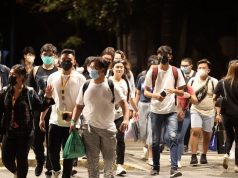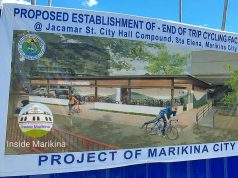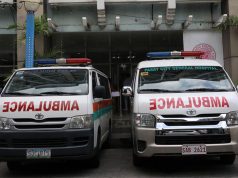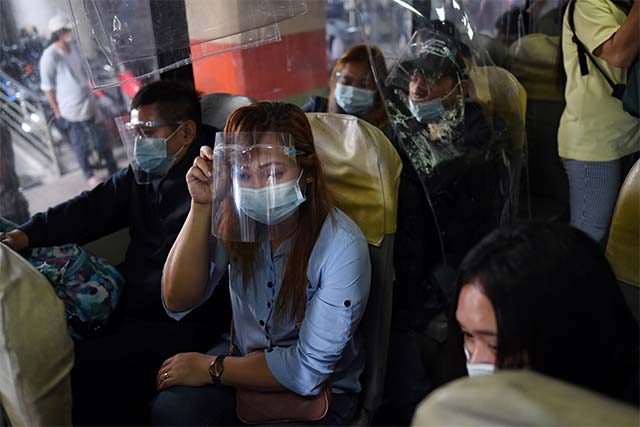
The debate over the necessity of face shields for protection against the coronavirus disease was brought up online after the Philippine General Hospital published an infographic about it on their Telegram channel.
The infographic was shared on Twitter by Axl Caesar Ofrecio, a postgraduate intern at the state-owned hospital.
The advisory dated February 4 was posted on UP-PGH COVID-19’s channel on Sunday, along with other infographics pertaining to personal protective equipment (PPE) suits that staff should wear inside the hospital amid the threat of COVID-19 and the new variant.
It noted that a face shield is needed “to protect eyes from potential mucosal contamination” and that it is “equivalent” to “googles” or “eyeglasses.”
“Eye protection should be worn during all patient contacts and should be disinfected regularly/recycled,” it continued.
Ofrecio shared the particular advisory and questioned the necessity of a full face shield in public as mandated by the government.
“Lol (laugh out loud) PGH na nga nag-i-implement ng ganito, so why can’t other non-healthcare establishments?” he wrote.
A full face shield is one that covers the entire face, from the forehead to the chin area.
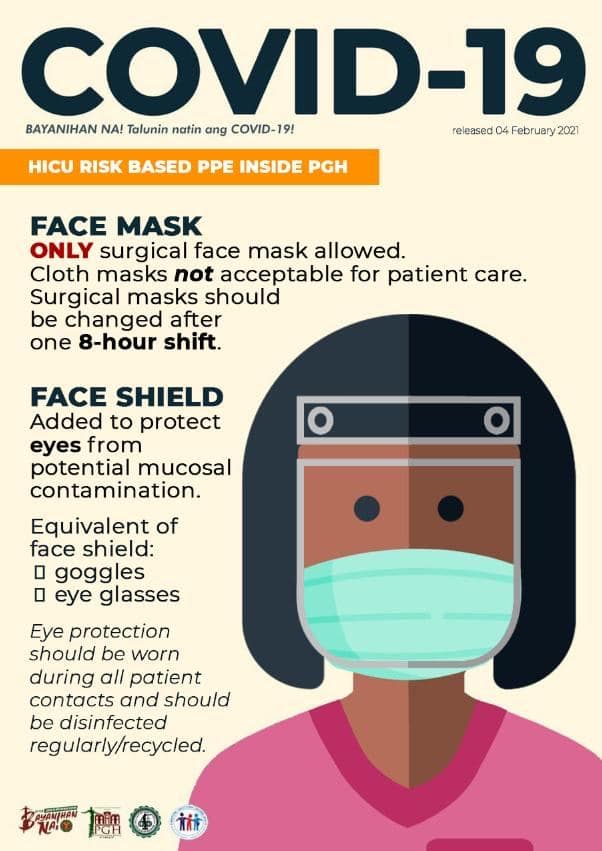
Others agreed with Ofrecio and claimed of having difficulty in wearing face shields on top of their own face masks, especially those who are also wearing eyeglasses.
“Hirap na hirap ako mag-face shield with eye glasses hahaha pwede naman pala. Thanks for the info,” a Twitter user claimed in the replies thread.
“Wearing face shield on top of eyeglasses, nahihirapan din ako, nag-iiba kasi (‘yung) clarity (talaga). Kaya nga ko nag-eyeglasses kasi may diperensya mata ko at para ‘di ako mapahamak, tapos papatungan ng face shield,” another online user wrote.
There were others, however, who noted that PGH is a different environment.
Dr. Winlove Mojica, a board-certified dermatologist, commented that the hospital is not a “crowded” environment unlike in public markets or public transports.
“Hindi po siksikan ang PGH. Hindi ito palengke. Hindi ito LRT. Hindi ito jeep. Strict ang zoning dito. At binago (ang) duty schedule para hindi puno ang mga clinics at opisina. Sarado din ang OPD (outpatient department). Lahat ng naka-admit may swab test,” he wrote.
Mojica further explained the “zoning” in PGH in another tweet.
Zoning sa PGH – depende sa kulay na assigned sa isang lugar at kung gaano ka katagal sa lugar ang isusuot mong PPE.
Example of zoning (Aug 27, 2020) pic.twitter.com/IUcFqzxoi4
— Dr. Winlove Mojica #stopthekillings (@theskinsensei) February 7, 2021
“Ang problema ‘pag wala ka sa PGH… hindi mo alam kung anong zone ka. Kung nasa LRT ka at siksikan doon at may asymptomatic, malamang at least orange zone ‘yun,” Mojica tweeted.
Another Twitter user aired similar sentiments and claimed that other public areas may not be so thoroughly sanitized as hospitals.
“That post will create misunderstanding again. Remember PGH is a controlled environment compared to a market, groceries, public transportation na karaniwan sobrang dami ng tao at (‘di) nasa-sanitize agad,” the online user wrote.
Face shield policy
Last December, the government made it mandatory for the public to wear face shields on top of the requisite face masks. The policy was met with some criticisms from the local online community.
A cycling group also aired its safety concerns over the face shield policy and cited that it may obscure a cyclist’s vision, especially at night.
A study published in the journal Physics of Fluids found that although face shields block the initial forward motion of cough or sneeze, the expelled droplets can move around the visor “with relative ease and spread out over a large area.”
The United States’ Centers for Disease Control and Prevention do not require face shields for normal everyday activities.
“Face shields and goggles are primarily used to protect the eyes of the person wearing it. Goggles do not cover the nose and mouth. Face shields have large gaps below and alongside the face, where your respiratory droplets may escape and reach others around you,” the CDC’s COVID-19 guidelines read.
Despite the mandatory wearing of face shields, the Department of Health said that the item is not advisable for those who have specific conditions and if it would lead to visibility problems.
It, however, maintained that face shields would provide people an additional layer of protection against the virus.
“What we are recommending is for people to use face shields together with face masks and do physical distancing, especially when you’re in public places because this will give you protection that you need so we don’t get infected with the virus,” Health Undersecretary Maria Rosario Vergeire said.
The Department of Transportation previously shared an infographic attributed to a 2020 study by Dans, Herrera, et al. about face shields.
It reportedly said that the wearing of face masks and face shields, coupled with physical distancing, could supposedly reduce the transmission of COVID-19 by 99%.




